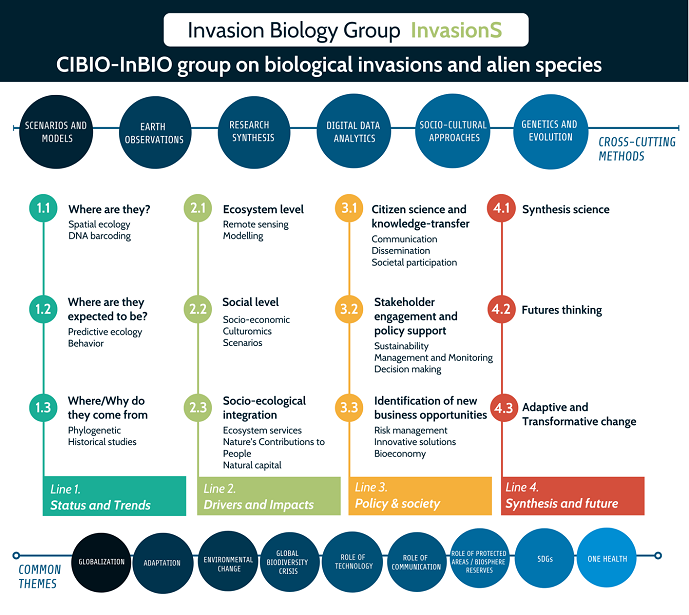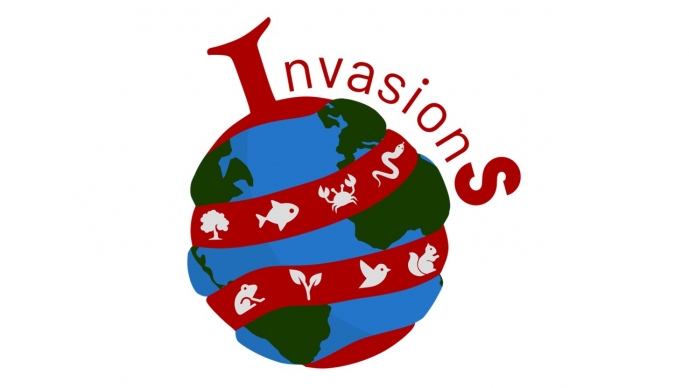Invasion Science - InvasionS
InvasionS will enable important progress in several dimensions of invasion research and policy. First and foremost, the group will contribute to advance the state of knowledge in invasion science, the expected advances in the state of knowledge will be disseminated through papers in high-profile journals. We also expect important progress in predictive modelling of biodiversity, namely through the inclusion of predictors from satellite Earth observations and invasiveness proxies related to introduction history as well as functional and phylogenetic traits. Through an explicit vulnerability and prioritization frameworks we expect to contribute to improve significantly the implementation of existing policy and management instruments as well as to produce more effective management tools at the science-policy interface. InvasionS is also expected to contribute with opportunities for the advanced training of graduated students and early-career researchers, for the capacity building at the various levels and agents of invasion management, and overall, for the consolidation of biological invasions as a core research field in CIBIO-InBIO (and beyond).
The objectives of InvasionS are very well aligned with InBIO´s scientific strategy (2018-2022), and especially with the theme line "Sustainability, Ecosystems & Environment”. This line aims to "understand the mechanisms of species invasions, from trade networks to species traits, and the effects of invaders on biodiversity and ecosystems, thus contributing to prevent invasions and optimizing the management of novel ecosystems”. More broadly, InvasionS will contribute to InBIO’s vision and mission, namely regarding the key objectives of transferring scientific knowledge to tackle societal challenges and developing excellence science research, to promote internationalisation and research collaborations, fostering participation in national and international networks and partnerships, including research infrastructures, and assuming leadership in international initiatives promoting training and maximise societal impact, by training the new generation of scientists and practitioners, opening science to society, and promoting knowledge and technology transfer to end users.
In this context, InvasionS will bring together the experience and motivation from the pioneering ALIENSWATCH research network to place itself as an active organism in wider national and international initiatives, placing invasion biology at the very forefront. From these initiatives we highlight the PORBIOTA, through which we aim to promote the organization, mobilization, standardization and dissemination of data pertaining to the multifaceted nature of biological invasions, thereby penetrating academic outputs into administration and society. Similarly, we emphasise our participation in the mainstream European Infrastructure Consortium of LIFEWATCH ERIC, in which we aim to reinforce the link to the development and construction of a strong cornerstone dedicated to invasion biology in the upcoming collaboration at the Iberian level through IBERWATCH.
The engagement of InvasionS in the e-LTER Plus programme of HORIZON 2020 is also a notable example to further built networking, joint research activities and transnational, remote and virtual access to relevant and scientifically sound developments in the arena of biological invasions. By doing so, we expect to contribute to significantly improve the implementation of existing policy and management instruments as well as to produce more effective future instruments, thereby further mainstreaming CIBIO-InBIO in the science-policy interface for invasion monitoring and management. The InvasionS members are active actors in the global biodiversity observation network, GEOBON, advancing knowledge, tools and collaborations in the journey to identify, assess and monitor Essential Biological Invasion Variables at the global scale, and in line with the expected EuropaBon mission and vision for the EU. Remarkably, InvasionS is strongly committed with the Intergovernmental Platform on Biodiversity and Ecosystem Services, IPBES, in which the PI represents one of the selected authors in the unprecedented assessment of biological invasions at the global scale.
How is InvasionS envisioned?
The vision of InvasionS is conceived under a penta-helix model of science and innovation dedicated to (Figure 1):
1. Fundamental research, by adopting a transdisciplinary approach focused on consolidating knowledge, challenging existing theory, and creating and developing new tools and databases on biological invasions.
2. Applied research, thereby advancing the practicability of scientific knowledge to real-world challenges with implications for the adaptive management of society, policy and business under the principles of the SDG agenda.
3. Societal engagement will be a cornerstone, through the development of social-cultural approaches that welcome the participation of the civil society, namely through Citizen Science and wider outreach and public awareness initiatives.
4. Advanced training, by becoming a group of excellence in the preparedness of researchers, stakeholders and decision-makers so they can aid with the best knowledge and tools to face current and future invasion challenges.
5. Collaboration networks, by becoming an ambitious group that expands collaborations to Africa and other continents, and tracing a profile fulfilled with outstanding scientific publications at the global level.

InvasionS will be dedicated to ask many What, Why and How questions in invasion biology at appropriated spatial (Where) and temporal scales (When) that are relevant for the scientific, political, business and societal communities (Who). During the next five years, InvasionS will be organized into four cross-cutting, complementary and collaborative theme areas (Figure 2)
1. Status & trends - InvasionS will seek to understand the past, the present and the future of biological invasions. For that, InvasionS welcomes (1.1) the integration of spatial ecology and DNA barcoding to identify where alien invasive species are. It will further include (1.2) predictive ecology and behaviour studies to understand where biological invasions may occur. Finally, it will embrace (1.3) phylogenetic and historical studies to unravel where and why do biological invasions exist.
2. Drivers & Impacts - InvasionS research and applicability will be developed at the ecosystem and social level, their integration. InvasionS will focus on (2.1) a genes to ecosystems approach, by means of advanced techniques (e.g. remote sensing and modelling) to understand how the invasion process works. It will further understand (2.2) how the invasion process is driven and affects the social system, including its socio-economy, by means of scenarios and culturomics tools (among many others), offering robust advances for the (2.3) social-ecological agenda of ecosystem services and nature’s contributions to people.
3. Policy & society - InvasionS research will also be devoted to the needs of policy, business and society. Such will be accomplished by putting emphasis on InvasionS participation in (3.1) Citizen Science and knowledge-transfer initiatives, namely through a strong dissemination and communication strategies that motivate social participation. InvasionS will also (3.2) aspire to support policy options targeting sustainability, monitoring and management of biological invasions, while helping the (3.3.) business sector in invasion risks and opportunities with repercussions to bioeconomy with innovative solutions.
4. Synthesis & Future - Through all the knowledge and practicability generated, InvasionS will have a strong dedication to (4.1) synthesising and understand existence knowledge and its gaps, by means of protocolized procedures and analysis (e.g., systematic reviews and meta-analysis). InvasionS will also be drawn to the relevance of biological invasions in upcoming decades, (4.2) adopting a futures thinking approach that is helpful in anticipating the course of invasion biology and thereby (4.3) providing the foundations for options comply with the principles of adaptive and transformative change at the science-policy-society interface.
Common to the four themes mentioned above, InvasionS will make use of the expertise and skills of its team members, adopting cross-cutting methods developed under the fields of Genetics and evolution, Scenarios and models, Research synthesis, Socio-cultural approaches, Earth observations and Digital data analytics. The four themes envisioned for InvasionS will inevitably link to the wider areas of globalisation (including trade) and social-ecological adaptation, while also consider other factors of environmental change (e.g. climate change and land use conversion) to assist on the monitoring of the environmental crisis and the management of protected areas (and biosphere reserves), using communication tools and technological advancements to meet the different SDG targets under the one health approach.
In order to achieve its ambitious goals, the InvasionS also expects to continue its collaborations with other research groups from CIBIO, while expanding new ones. InvasionS is also aligned with the BIOPOLIS strategy and will therefore pursuit the establishment of important collaborations with the Université de Montpellier. In fact, the PI, co-PI and team members of InvasionS are already in collaboration form academics and researchers from the Université de Montpellier. Among the many institutions and research groups which make part of the Université de Montpellier, InvasionS already foresees important collaborations with the following (among others):
● Cirad - French Agricultural Research Centre for International Development, namely through the groups on Dynamics of Natural Forests, the Centre for Biology and Management of Populations, and the group on Pests and Diseases: Risk Analysis and Control.
● CNRS - French National Centre for Scientific Research, namely though the Institute of Biological Sciences (INSB), and the Institute of Ecology and Environment (INEE).
● IFREMER - L'Institut Français de Recherche pour l'Exploitation de la Mer, namely thorugh the Laboratoire d’écologie benthique côtière.
● INRIA - National Institute for Research in Digital Science and Technology, namely though their thematic lines Data science, Artificial intelligence, High performance computing, Software, and Digital education.
● INRAE - French National Research Institute for Agriculture, Food and the Environment, namely through the thematic Group 4 on Biology, ecology and evolution of invasive species.

